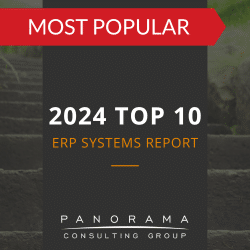If you’re on the cusp of a digital transformation, it’s important to remember that a successful transformation requires more than just the right technology. It requires a foundation of reliable data, optimized processes, and a fully equipped end-user base.
Today, we’re sharing a few change management techniques you can use to address the third part of this equation.
8 Change Management Techniques to Employ in Your Upcoming Project
1. Secure Executive Sponsorship
One of the most effective organizational change management (OCM) techniques is to secure executive sponsorship as early as possible.
A sponsor is someone who’s visible and strategically engaged during all project stages. This person can work with the project team to ensure OCM receives the attention, funding, and resources it requires.
ERP Training Plan Success Story
We helped this manufacturer implement an ERP training strategy to increase user adoption of its new ERP system.
2. Conduct a Readiness Assessment
Your project team might be eager to initiate a digital transformation, but is your organization truly capable of supporting such a massive change?
Before you dive into the project, take the time to conduct a readiness assessment. This can help you anticipate how much resistance you might encounter if you start implementing changes.
To conduct this assessment, consider the scope of the change and the effect it will have on your company culture and individual employees.
3. Structure Your Approach
It isn’t enough to just say that your team will focus on change management; you need an OCM plan in place to make it happen.
Your change management plan should encompass strategies and tactics for involving employees in every project phase.
Why is employee involvement important? Our ERP implementation consultants can attest that end-users are more likely to adopt new software when they’ve had a say in the entire process.
4. Plan Your Communication Strategy
Your company’s change management process hinges on effective communication. This means team meetings as well as one-on-one conversations.
In all modes of communication, it’s important to tailor your message to key stakeholders and emphasize the benefits relevant to their role.
Imagine you’re implementing an AI-powered customer service chatbot. You could tailor your message to the customer success manager by emphasizing how the chatbot will free up their team’s time, allowing them to build stronger relationships.
(Learn about AI in ERP.)
5. Invest in End-User Training
When thinking about managing organizational change, one of the first activities that pops into project managers’ minds is training.
Indeed, with new technology and new business processes comes the need to train employees. While this is an obvious change management technique, it’s not a standalone activity.
For instance, your process improvement initiative should be fully integrated into your training strategy. While improving your processes, you must document the impact of each change so you can tailor your training to specific employee groups.
6. Expect and Prepare for Resistance
As you implement organizational change, you’re bound to encounter some form of resistance.
There may be senior managers, or other stakeholders, who aren’t on board with the project, and their negativity could spread to their respective departments.
Instead of sweeping those opinions aside, take the time to listen to your employees. Then, develop a resistance management plan detailing how you will address their concerns and answer their questions.
7. Reinforce Change
Successful change management is ongoing. In other words, once your new software goes live, don’t file away that OCM plan.
Reinforcing change can send a clear message that user adoption is a priority.
Consider celebrating every milestone as you achieve both short term and long-term benefits.
At the same time, be sure to recognize employees who are actively embracing the change and work closely with those who are struggling to do so.
8. Measure Results
Before you even start comparing analytics tools or beginning ERP selection, you must establish key performance indicators (KPIs). These are metrics that will help you measure project success and understand the effectiveness of your organizational change management strategy.
Are users actively using the new system, or are they holding tight to their old processes? Is user adoption so low that you need to consider ERP project recovery?
Successful Change Management Starts With Expert Guidance
As you begin your digital transformation, remember to implement change management techniques at every turn. Unless the human side of the project is as well-planned as the technical side, your project could fail to deliver on expectations.
Our change management consultants can help you develop an OCM plan that makes sense for your organization. Contact us below for a free consultation.














